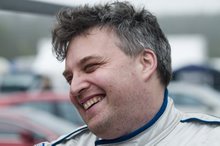The sensor measures the unburnt oxygen in the exhaust and is a crucial tool for getting the best out of an engine. This is the same similar kit that many rolling roads wi
ll use.
The sensor monitors the unburnt oxygen in the exhaust, in perfect conditions a ratio of 14.7 parts air to 1 part fuel will result in all the available oxygen being burnt with the fuel and therefore maximum efficiency and fuel economy. This is the Stoichiometric ratio or "Stoich". But the world is seldom a perfect place and due to factors like flame front travel time across the cylinder at ignition it may be that all the oxygen atoms don't get a chance to to meet a compatible hydrocarbon molecule and do their inciendary tango before the exhaust valve opens. Therefore in performance cars or under heavy acceleration you want more fuel in the cylinders than the stoich ratio would suggest, to ensur
e that all possible energy is derived from burning a
ll the available oxygen. Because I can add more fuel but I can't add more oxygen without either Nitrous
injection or forced induction I use the AFR numbers to control my engines fueling via a Power Commander USB piggy back controller. Max power for petrol is engine dependent and varies with the engine's combustion characteristics but is usually in the range 12.5-13.7 AFR
Since discovering I was running lean earlier in the year I been monitoring the AFR numbers in the logger and I was surprised to learn after Anglesey that I was running very rich AFR approx 10 which is certainly costing me power. The Power Commander allows me to tailor my fueling by adding or removing fuel in each of the throttle positions 2,5,10,20,40,60,80 and 100% at 250rpm intervals across the rev range. (some 376 cells)

So I've been doing some fairly extensive AFR analysis, which basically involves the following steps
- Export the data from the DL1 as a CSV file, typically this is 120000 rows of data
- Load into excel
- Write a few formulae to exclude any values that are not under acceleration, or not in the middle 50% of the target range for each rpm or throttle cell.
- Pivot table the results to produce an average of the selected valid entries
- Decide on my target AFR (13.4) and produce a variance table.
- Using a multiplier (based on experience from earlier changes) to produce a table of changes that I can apply to my PowerCommander Fuel Map to hit the the target AFR across the range.
A graph of the the results is above.
While this is not the best way to interpret the figures (staring at the table of numbers colour coded by variance from the target does that) you can see that there is lean peak at around 4000RPm at 20% throttle, and that there are also a couple of lean peaks at around 8000 RPM at 80% throttle. I need to add fuel here. I'm also pretty rich at the midrange where I need to reduce fuelling. I'm not really bothered about low throttle openings as in a racer you very rarely in this position. You can also see that even at the 100% throttle position (closest to the view) the AFR value gradually leans off as you go from 4000rpm to 12000 rpm. This I am looking to correct.
Mainly I'm interested in the 100% throttle range, but I am also progressively cleaning up the rest of the map to get a good clean throttle response. Once I'm hitting my target AFR across the range I can then use the BHP and torque calculators in the DL1 analysis software to identify if my target of 13.4 is correct. Is 13.6 better or would 13 give more power? With the map dialled in across the board it's a 10 second job to add a small percentage of fuel everywhere. Anyway it is interesting stuff and I've learned a few things in he process





No comments:
Post a Comment